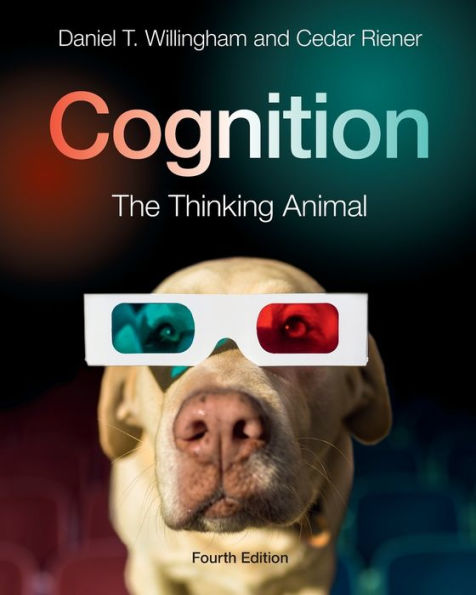Cognition: The Thinking Animal / Edition 4 available in Paperback, eBook

Cognition: The Thinking Animal / Edition 4
- ISBN-10:
- 1107525128
- ISBN-13:
- 9781107525122
- Pub. Date:
- 08/01/2019
- Publisher:
- Cambridge University Press
- ISBN-10:
- 1107525128
- ISBN-13:
- 9781107525122
- Pub. Date:
- 08/01/2019
- Publisher:
- Cambridge University Press

Cognition: The Thinking Animal / Edition 4
Buy New
$99.99Buy Used
$77.76-
SHIP THIS ITEMIn stock. Ships in 3-7 days. Typically arrives in 3 weeks.PICK UP IN STORE
Your local store may have stock of this item.
Available within 2 business hours
$77.76$99.99Save 22% Current price is $77.76, Original price is $99.99. You Save 22%.-
SHIP THIS ITEM
Temporarily Out of Stock Online
Please check back later for updated availability.
Overview

Product Details
| ISBN-13: | 9781107525122 |
|---|---|
| Publisher: | Cambridge University Press |
| Publication date: | 08/01/2019 |
| Edition description: | 4th Revised ed. |
| Pages: | 448 |
| Product dimensions: | 8.07(w) x 10.00(h) x 0.87(d) |
About the Author
Cedar Riener is a cognitive psychologist and Associate Professor of Psychology at Randolph-Macon College, Virginia. He researches perception of the natural world and how the state of our body influences that perception.
Table of Contents
1. Introduction: cognitive psychologists' approach to research; 2. Methods of cognitive psychology; 3. Visual perception; 4. Attention; 5. Sensory and working memory; 6. Long term memory structure; 7. Long term memory processes. Memory encoding; 8. Memory retrieval; 9. Concepts and categories; 10. Language structure; 11. Language processing; 12. Visual imagery; 13. Decision making and reasoning; 14. Problem solving.Introduction
A long-standing goal of human enquiry is to understand ourselves. How can we characterize the human species? Here are some well-known definitions of "man."
Man is by nature a political animal.—Aristotle
Man is a noble animal.—Sir Thomas Browne
Man is a tool-using animal.—Thomas Carlyle
Man is a reasoning animal.—Seneca
Man is a social animal.—Benedict Spinoza
Man is a rational animal who always loses his temper when he is called upon to act in accordance with the dictates of reason.—Oscar Wilde
All these proposals are, in a sense, correct, but are all rooted in another characteristic. We are able to act politically, use tools effectively, understand nobility, and so on because of our ability to think. The book you are reading is a study of cognition—of how humans think.
READABILITYCognitive psychology does not seem to have the intrinsic interest of some other areas of the field. Textbook authors are aware of this problem, but to be honest, I've never cared much for their remedies. The usual strategy is to include "real world" examples and demonstrations, usually found in little boxes that appear every few pages. This strategy seems to confirm. the reader's growing suspicion that they are bored by sending the implicit message. "Yes, yes, I know this stuff is boring, but hang in there, and every few pages I'll toss in one of those boxes with a demonstration or real-world application to keep you going."
I've done three things in this book to try to arouse readers' interest in the material.
- I have explicitly stated the questions that motivate cognitive psychologists. Thesequestions we ask are of general interest, but psychologists don't always do the best job of explaining the questions in any detail. We plunge right into the answers, which seem arcane. Each chapter in this book is organized around two or three straightforward questions that are easy to appreciate and explained in detail.
- To the extent possible, I have used a narrative structure. By that I mean that there are causal links within and across chapter sections, so that it is clear why you are reading something. Nothing is more boring than a list of unconnected facts.
- I have tried to write in a non-stilted, not-especially-academic style.
Despite the light tone, this book is not light in content. An easy way to check the coverage is by examining the key terms section at the end of each chapter.
PEDAGOGYReadability is fine, but the goal of a textbook is, after all, that students learn the material. Different students like and use different pedagogical features, so I've included a few different ones to help them learn.
- A brief preview poses the broad questions and provides the broad answers covered in each section.
- Key terms are identified by boldface type and are defined immediately thereafter. They are also collected in a glossary.
- Each section closes with a series of questions. The "stand-on-one-foot" summary questions ask students to summarize what they learned in the section they just read. The name comes from the Talmudic story of the heretic who went to great sages, asking each to summarize all of the Torah during the time he could stand on one foot. (He finally found a willing sage in Hillel, who quoted from Leviticus: "What is hateful to you, do not to others.") The idea is simply to get readers to pause for a moment and make sure they understood the major points.
- The end of each section also includes questions that require considerably more thought; the student will need to apply what he or she has just learned to new situations, or go beyond the material in some way. I call these "questions that require two feet." Answers to all questions are provided at the back of the book.
I've also included an appendix containing background information and explanations of several concepts, such as statistical significance, that will be familiar to students who have taken other psychology courses but that beginning students may not know.
THE BRAINThe influence of neuroscience on cognitive psychology is substantial and increasing. This trend poses two problems for teachers of cognitive psychology courses: how much of this material to include (given that it could support a semester-long course) and how to deal with the fact that understanding cognitive neuroscience requires some background knowledge of the brain.
With regard to background, there is a section of the book titled "Interlude: The Brain" after chapter 1. Other cognitive textbooks include some description of neuroscience, but I handle this topic a bit differently. I don't think it's optimal to try to present the basics of neuroscience in a dozen pages. The truth is that much of the basic material (such as the workings of an action potential) is not needed for beginning cognitive neuroscience. Instead, I focus on three points: (1) Why do cognitive psychologists want to learn about the brain? /2) How do they gather information about the brain? (3) What are the brain structures that cognitive neuroscientists frequently refer to?
How much cognitive neuroscience should be in a cognitive psychology textbook? My goal is to give the instructor some flexibility. Certain findings have had such an impact on cognitive psychology that they simply must be part of any course. I have tried to describe these findings in a way that assumes no background on the part of the student. For the instructor who prefers a greater emphasis on cognitive neuroscience, I have included additional materials. Besides the "Interlude," key studies from cognitive neuroscience are discussed in supplemental boxes set off from the main text. Those instructors who place less emphasis on cognitive neuroscientific approaches can, of course, instruct students to simply skip over this material.
I hope that I have written a textbook that will make students enthusiastic about this field and will make them want to know more than they can find in this book. Hillel's answer to the impatient heretic is not always quoted in full; after providing the summary of the Torah, Hillel added, "Now go and study," acknowledging that a one-sentence summary was bound to be lacking and that the heretic should learn more. I have not succeeded in summarizing cognitive psychology in a sentence, but I hope that this book will serve as a starting point for students who will then want to learn more about the field.
